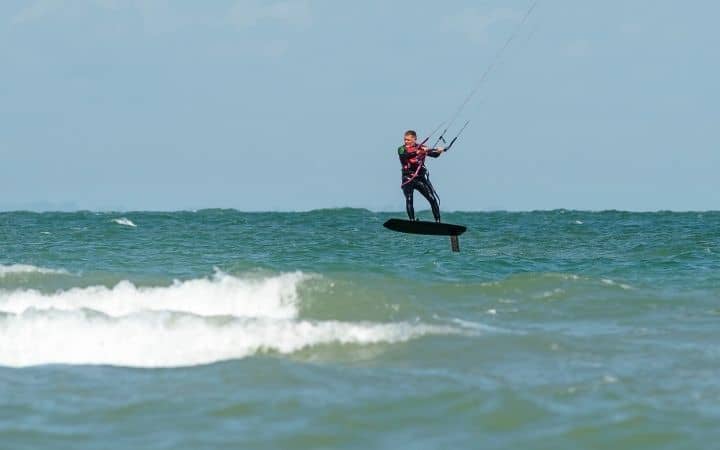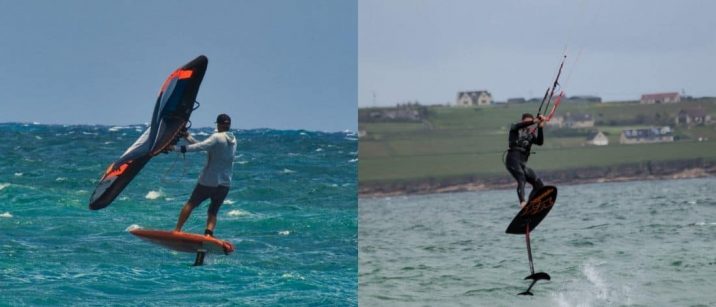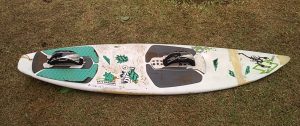In the last few years, wing foiling has hit the ocean sport scene with much the same rapid rise in popularity as kite foiling did close to 10 years ago. A recurring question among newbies and seasoned kiters alike is which should I choose?
Wing foiling still can’t compete with kite foiling for speed, light wind, or jumps. However, it opens up new territory in terms of locations, conditions, and accessibility to new riders. Rider skills and equipment capabilities are expanding dramatically, making wing foiling increasingly attractive.
To some people, wing foiling looks awkward or uninteresting, but there’s a lot more to it than meets the eye. Also, there is one particular type of riding that can be only be done on a wing foil! Read on for more.
Table of Contents
Key differences between wingfoil & kitefoil
Kites can develop much greater power surges than wings. This allows kite foilers to ride faster, jump higher, and use smaller boards and foils.
But kites are also more complicated, and more difficult to learn. They can be more hazardous to use, and more limited in the places they can be used.
Wing hydrofoils tend to be in the 1500 to 2500 cm2 (for learners), while 1500 cm2 is quite large for a kite foiler. It’s a good size to learn on, but most kite foilers then move down to 600-800 cm2 foils.
Kite foilers can waterstart in the same way as regular kiters, lying on their back with the foilboard at their feet. On the other hand, wing foilers must start by balancing on the board on their knees, then pump the wing to get flying on the foil.
Starting on a wing foil takes more effort than a kite foiling waterstart. As a result, wing foilers need to start with much larger boards, typically 20 liters more volume than their body weight.
Later on, a wing foiler may use about a 70-80 liter board, which is still much larger than a kitefoil board.
That said, there are some niches that only wing foiling can fill. Gusty wind, offshore wind, narrow or crowded beach locations are typically obstacles for kiters. Wing foilers, on the other hand, just don’t have to worry about these factors.
Wings also has a key advantage over kites: being able to ride a wave with 100% depower. The wing just floats with no power while you ride the swell. In contrast, a kite will always retain some amount of power.
Wing foil vs kite foil: which is easier to learn and ride?
For a beginner who has no background in water sports at all, wing foiling will take much less time to learn.
Unlike kiting, it’s even possible to learn to wing foil without lessons.
For someone with some background already, think of three separate skill sets: how to use a wing, how to fly a kite, and how to ride a foil.
Learning how to hold and use a wing takes far less time than learning to control a kite. So if you are a kitesurfer who has never used a foil, it’s not that big a step to move to kite foiling.
If you are a windsurfer, foil surfer or foil stand-up paddler who already knows how ride a foil, wing foiling will be easier to learn than kite foiling. Controlling a wing has more similarities to a windsurf sail than it does to a kite.
In contrast, if you’re new to power kites, you will need to go through a time-consuming learning curve before you can adequately control and fly your kite.
As mentioned, because wings don’t produce as much power as kites, wing foils tend to be larger than kite foils. The bigger foil size makes wing foiling more accessible to beginners, and easier to learn.
Wing foil vs kite foil: which has a better wind range?
Kite foilers can get flying on the foil in lighter wind than wing foilers. An average kite foiler is comfortable riding around in less than 10 knots, whereas a wing foiler will struggle in less than 15 knots.
At the other end of the wind range, wing foils are easier to handle in strong winds. At 30 knots a kite foiler may be in for a scary or difficult time, while a wing foiler can handle things more easily.
This is partly because a kite can’t depower all the way like a wing can. A kite which has depowered 100% is a kite that is falling onto the water.
Which is better for upwind and downwind riding?
With the gear on the market today, a kite foiler can ride much closer to the wind (higher upwind) than a wing foiler.
A wing foiler can only go about as far upwind as a windsurfer, or a kitesurfer on twintip.
On the other hand, the beauty of a wing foil is that it can be 100% depowered, which allows the rider to go straight downwind. This helps with riding swells. For most kites, a straight downwind line is nearly impossible.
Wing foiling vs kite foiling for the surf?

It’s important to distinguish between riding in the surf, and riding swells. Surf breaking in shallow water close to the beach is extremely dangerous for both kite foilers and wing foilers.
It may be even more difficult to bring a wing foil setup out past a shore break than a kite foil.
With a kite foil, you can ride in waves, but you can’t solely use the power of the wave for surfing it. The kite needs to always have tension in the lines, which limits the downwind runs a kiter can do – e.g. when riding down the face of the wave staying close to the curl.
Riding swells downwind in open ocean, or on waves in deep water, is where wing foiling excels the most. Once you get on the swell, you can release your back hand on the wing and let it float with no power, and actually ride the swell with your foil.
Which of wing foiling and kite foiling is faster and better for jumps?
Kite foilers can achieve higher speeds than wing foilers. The larger foils used by wing foilers limit their speed, and the great power surges that a kite can produce, e.g. through kiteloops, are not available to the wing foiler.
Jumps are generally higher with kite foiling for the same reasons. But keep in mind that the progression to jumping with a kite foil is limited to a relatively small number of people with very high skills. Crashing onto a foil when landing a jump can cause severe injuries.
Is wing foiling or kite foiling safer?
Wing foiling is undoubtedly safer than kite foiling. Flying a kite presents many risks that are generally not a concern in wing foiling.
In case of trouble, it’s much easier to paddle back upwind or back to the beach with a wing foil than it is to self-rescue with a kite foil. Wing foiling boards usually have more volume, allowing the rider to lie on them and drag the wing behind, and without worrying about a set of tangled kite lines.
Wing foil vs kite foil: which is easier to set up?
Wing foils are much easier to set up, with no kite lines to worry about. You can also set up and go out in a much smaller place, with less worry about crowded beaches.
That said, wing foil boards and foils are bigger than kite foils, so carry your wing foiling equipment to the beach over some distance can be more challenging and awkward.
Wing foil vs kite foil: which costs more?
Total cost of gear is roughly the same for a wing foil setup and a kite foil setup. Wings tend to cost slightly less than kites and don’t require a bar and lines. But the boards and foils needed for wing foiling are more expensive.
Of course, there is a wide variety in price ranges, but as a rule, expect to pay roughly $400 more for a wing foil board vs a kite foil board, and $200 more for the foil itself.
Check out kite foil prices and wing foil prices on Green Hat.
If you’re coming from kiting, you can use your regular kite and just buy a kite foil board to start kite foiling. For wing foiling, on the other hand, you’d have to buy both a wing and a wing-specific foil board.
If you’re coming from stand-up paddle foiling, you can start with using your stand-up paddle foilboard, but will eventually you’ll need to buy a wingfoil board that you can use with your existing paddle foil.
In conclusion
Wing foiling is only in its early stages of development; it’s only in the last two to three years that wing foiling has started to become more popular. Think of it like the first years of kitesurfing, when people used two-line kites, and when twintip boards were not available yet.
There’s no doubt that riding skill levels will increase, and the equipment designs will progress. The efficiency of the wings themselves is getting better. Look for higher speeds, easier jumps, and better upwind.
***
Image credits:
Featured image – left side: “Wing Surfers” (CC BY-SA 2.0) by Kirt Edblom
Featured image – right side: “paul on foil.jpg” (CC BY 2.0) by silverback44



